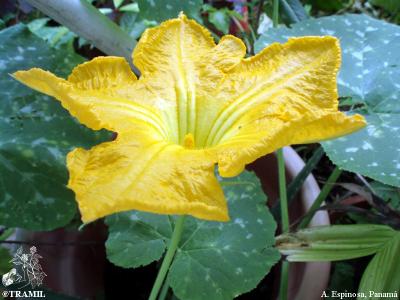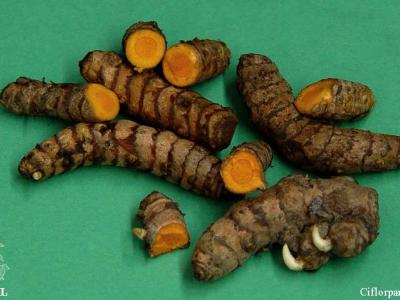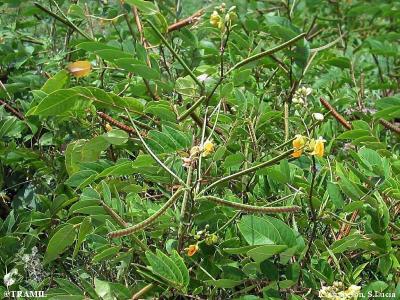(In territories with significant traditional TRAMIL use)
Dominican Republic:
- auyama
Haiti:
- jiroumou
- jiwomon
flower, decoction or infusion, orally2
According to the information available:
The use for asthenia, weakness, jaundice and superficial burns is classified as REC based on the significant traditional use documented in the TRAMIL surveys and the toxicity studies.
Due to the health risk of liver conditions (jaundice), an initial medical assessment is recommended. The use of this resource must be considered complementary to medical treatment, unless contraindicated. If deterioration is observed in the patient or the jaundice persists for more than 3 days, seek medical attention.
Use should be limited to superficial burns (epidermal damage) that are minor (less than 10% of the body surface) and located outside high-risk areas such as the face, hands, feet and genitals.
All topical application must follow strict hygiene measures that prevent contamination or additional infection.
Not for use during pregnancy, breastfeeding or in children under 5 years.
The fruit and flower of Cucurbita moschata are foods of relatively widespread human consumption.
For asthenia or weakness:
prepare a broth with 30 grams of stems and leaves in 4 cups (1 litre) of water. Drink 3 cups a day.
For jaundice:
prepare a decoction or infusion with 5-7 grams of flowers in 1 cup (250 millilitres) of water. For decoctions, boil for 5 minutes in a covered vessel. For the infusion, add the boiling water to the 5 grams of flowers and cover. Leave to stand for 5 minutes, cool,strain (filter) and drink 1 cup 3 times a day17.
For burns:
wash the injury with boiled water and soap, apply the leaf juice to the affected area in sufficient quantities. Cover with a dressing or clean cloth and change twice a day.
Preparations must never be stored for more than 24 hours, even if refrigerated.
1 WENIGER B, ROUZIER M, 1986
Enquête TRAMIL. Service Oecuménique d'Entraide SOE, Port au Prince, Haïti.
2 WENIGER B, 1987-88
Encuesta TRAMIL. enda-caribe, Santo Domingo, Rep. Dominicana.
3 HEGNAUER R, 1973
Chemotaxonomy der Pflanzen. Basel, Schweiz: Birkhauser Verlag. 6:882.
4 WASHUTTL J, Reiderer P, Bancher E, 1973
A qualitative and quantitative study of sugar-alcohols in several foods. J Food Sci 38(7):1262-1263.
5 DUKE JA, 2000
Chemicals and their biological activities in: Cucurbita moschata. Dr. Duke’s Phytochemical and Ethnobotanical Databases. USDA-ARS-NGRL, Beltsville Agricultural Research Center, Beltsville, USA, August 10, 2000. www.ars-grin.gov/cgi-bin/duke/farmacy2.pl
6 BANG MH, HAN JT, KIM HY, PARK YD, PARK CH, LEE KR, BAEK NI, 2002
13-Hydroxy-9Z,11E,15E-octadecatrienoic acid from the leaves of Cucurbita moschata. Arch Pharm Res 25(4):438-440.
7 DUKE JA, ATCHLEY AA, 1986
Handbook of proximate analysis tables of higher plants. Boca Raton, USA: CRC Press. p55.
8 USDA
www.nal.usda.gov/fnic/cgi-bin/nut_search.pl?squash
9 HERRERA J, 1992
Determinación de parámetros farmacológicos usados en medicina tradicional popular en la cuenca del Caribe. Informe TRAMIL. Laboratorio de Fitofarmacología, Dep. de Farmacología, Facultad de Salud, Universidad del Valle, Cali, Colombia.
10 PAZOS L, COTO T, CAIZA F, 2008
Antiinflamatorio tópico, en ratones, de la hoja de Curcubita moschata. Informe TRAMIL, Laboratorio de Ensayos Biológicos, LEBi, Universidad de Costa Rica, San Pedro, Costa Rica.
11 VILENCHIK M, 1989
Fundamentos biológicos del envejecimiento y la longevidad. Moscú, URSS: Ed. MIR.
12 HERRERA J, 1990
Determinación de parámetros farmacológicos de vegetales utilizados en medicina tradicional en la cuenca del Caribe. Informe TRAMIL. Laboratorio de Fitofarmacología, Dep. de Farmacología, Facultad de Salud, Universidad del Valle, Cali, Colombia.
13 WENIGER B, 1992
Cytotoxicité, effets immunodulateurs et morphologique des extraits éthanolique 80% et aqueux de feuille de Cucurbita. Rapport TRAMIL. Faculté de Pharmacie, Université de Strasbourg, Illkirch, France.
14 HURTADO M, CARBALLO A, 1990
Las plantas medicinales TRAMIL en la farmacopea Soviética. Centro de Investigaciones de Fitoterapia y Medicina Tradicional, Topes de Collantes, Cuba.
15 PARIS R, MOYSE H, 1981
Précis de matière médicale. Paris, France: Ed. Maloine.
16 CHEN ZK, PU TC, LI DY, JIANG HA, 1980
Therapeutic effect of cucurbitine on dog taeniasis. Zhongguo Yao Li Xue Bao 1(2):124-126.
17 ALBORNOZ A, 1993
Medicina tradicional herbaria. Guía de Fitoterapia. Caracas, Venezuela: Editorial Instituto Farmacoterápico Latino S.A. p226.




